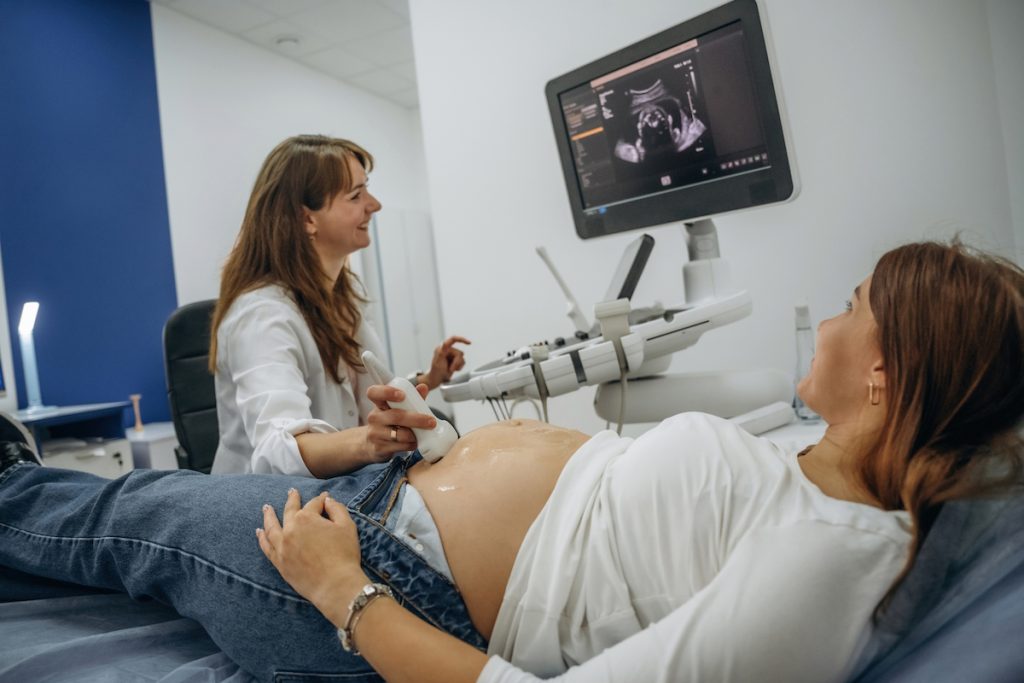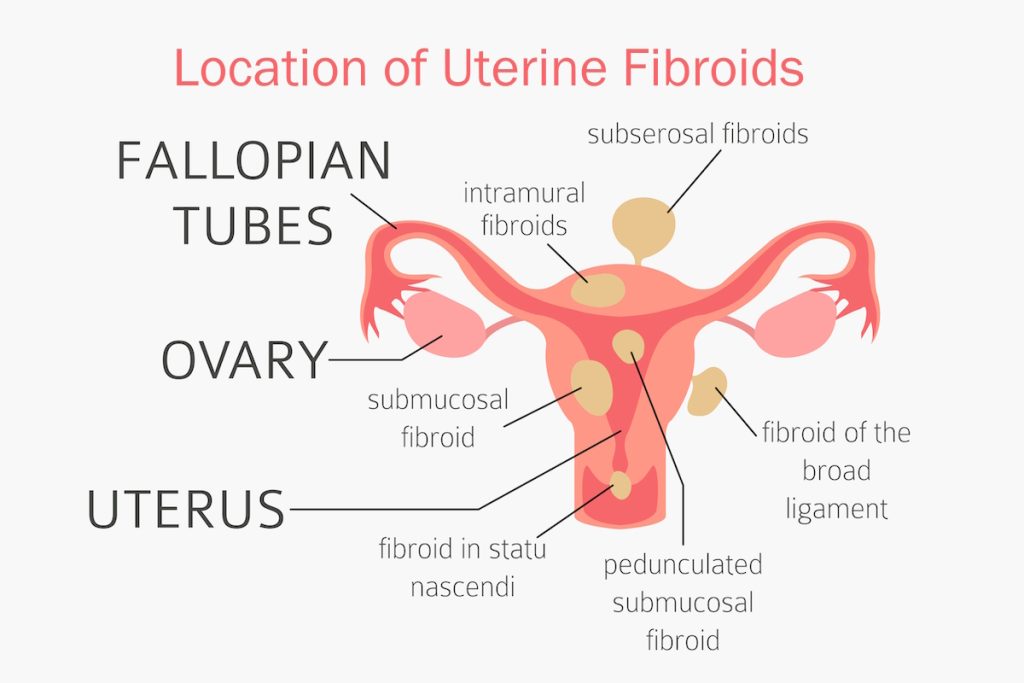Kendra* couldn’t have been more excited when she got pregnant three months ago. She had dreamed of motherhood for years and couldn’t wait to see her family grow. But during a routine exam and subsequent ultrasound, Kendra’s doctor gave her some unexpected news: she had uterine fibroids. And not just one, either. She had several small, noncancerous tumors in and around her uterus. As you can imagine, she had a million questions. The good news was that she wasn’t experiencing any fibroid pain—she was unaware she even had them until that appointment. But did that matter? Could she have a healthy pregnancy with uterine fibroids? What would the delivery be like months from then? Would her baby be safe? Was there anything she could do in that moment to fix this?
If you’ve found yourself in Kendra’s shoes, you’re not alone. Researchers estimate that 70-80 percent of all women develop fibroids between the ages of 35 and 54, though they can be just as common among even younger women of childbearing age. Some experience symptoms, but many others do not, which is why they sometimes don’t know they have fibroids until pregnancy brings them to light. As a result, pregnant mothers can be nervous about what happens next and need sound advice to ease their concerns. Here’s the good news: While uterine fibroids can increase your chances of a difficult pregnancy or even a miscarriage, many pregnant women with fibroids go on to have a healthy pregnancy and healthy babies.
First Things First: How Uterine Fibroids Can Affect Pregnancy
Your pregnancy can absolutely go off without a hitch, even if you have uterine fibroids. So, please don’t view your diagnosis as alarming. For starters, it’s better to know during the early stages of pregnancy than to be caught off guard during delivery. Additionally, your doctor will likely recommend a wait-and-see approach, especially if you were unaware of the condition, are asymptomatic, and otherwise appear to have a healthy pregnancy.
That said, it is essential to know if you have fibroids during pregnancy and work with your doctor to monitor them and have a game plan in place. Uterine fibroids develop in and around the uterus, which, as you know, is where your baby grows. Depending on your situation, you may have one or several like Kendra. Furthermore, your fibroids can vary in size and grow at different rates.

It’s the size, location, and growth rate that can affect a pregnancy, leading to:
- Possible changes to the shape of your cervix
- The baby being abnormally positioned in the uterus
- Abnormal blood loss during or after delivery
- Blood flow being limited to the placenta, causing a miscarriage
- Weak contractions
- Premature birth
- A higher likelihood of a cesarean section
A perfect example of these potential complications happened to another young mother, Yasamin*. Unlike Kendra’s story above, Yasmin knew she had fibroids at a very young age. That didn’t prevent her pregnancy, though it did lead to a highly traumatic delivery where her uterine fibroids had grown to the point where she needed an emergency C-section. When the doctors performed the procedure, Yasamin experienced a huge blood loss. Additionally, the fibroids were in the way and, at times, prevented the doctors from performing their duties.
“It wasn’t something the doctor was expecting to happen,” she said.
Pregnancy Complications From Uterine Fibroids Are Rare
The good news about uterine fibroids and pregnancy is that while many women develop fibroids in their lifetime, only 20% experience symptoms. This can include everything from pelvic pain and pressure to abnormally long periods, heavy and painful periods, bloating, urinary dysfunction, weight gain, back and leg pain, and more. Therefore, pregnancy complications resulting from fibroids are generally not an issue.
According to the American Society for Reproductive Medicine, fibroids are found in only 2% to 12% of pregnant women. Furthermore, most fibroids do not become excessively large or cause the problems mentioned above.
If a fibroid grows, it usually does so in the first 12 weeks of pregnancy. In most cases, a small number of fibroids isn’t a major concern. Still, their size, number, and where they develop can play a role. Since fibroids can be as tiny as a coin or grow as large as a basketball, your OBGYN will keep a close watch for any factors that might create complications during pregnancy.

If you are pregnant, and your gynecologist discovers that you have uterine fibroids, they will create a care plan tailored to your situation. This may include all or some of the following strategies:
- Baseline assessment — Your OBGYN will note the size, number, and location of fibroids through ultrasound to better predict whether they could interfere with the pregnancy. This is hugely important to ensure that no one is caught off guard about the location, size, and what to do if a uterine fibroid becomes a problem.
- Closer monitoring — You may be scheduled for more frequent ultrasounds to check the growth of the fibroids and ensure the baby has enough room to develop properly. Remember that large fibroids can occasionally limit space in the uterus and make it harder for the baby to move into the optimal head-down position.
- Ongoing evaluation of symptoms — Your gynecologist will ask about pain, cramping, or bleeding and may recommend safe pain relief options if symptoms become uncomfortable.
- Monitoring fibroid growth — Fibroids often grow during the first trimester due to hormonal changes, so gynecologists pay special attention early in pregnancy. Some may stabilize or even shrink later on.
- Customized birth planning — If fibroids are positioned near the cervix or lower uterus, your OBGYN may discuss delivery alternatives, such as a scheduled cesarean, to avoid complications during labor.
- Referral if needed — In rare cases where fibroids multiply or pose significant risks, your OBGYN may refer you to a maternal-fetal medicine specialist for more advanced monitoring.
UFE Before or After Pregnancy Is an Option
Many women with fibroids who wish to get pregnant or have been pregnant in the past may choose to have their fibroids removed. While uterine fibroids should not be removed during pregnancy, it is a possible option before pregnancy or down the road depending on your case. For Yasamin, she was required to have checkups every six months after her child was born. At one point, her doctor said the fibroids were growing again, and there was concern for having to undergo another massive surgery. That’s when the doctor suggested microscopic hysterectomy or uterine fibroid embolization (UFE).
“Choosing UFE was the best decision I ever made, and my only wish is that I had done it sooner,” Yasamin said.
With this minimally invasive procedure, the goal is to cut off blood flow to the fibroids rather than having them surgically removed. UFE works because it involves making only a tiny puncture on your left wrist where a very small catheter is inserted. Our fibroid doctors use X-ray guidance to locate the vessels that supply blood to your fibroids. Small particles are injected into the vessels, blocking blood flow to the fibroids, causing them to shrink and die. UFE can shrink all fibroids. Even if the fibroid is the size of a pumpkin, the procedure can shrink it up to 50% on average and, more importantly, cause the fibroid to be classified as dead.
UFE is the treatment of choice for our qualified patients for many reasons, one being that it treats all fibroids simultaneously.

“The best part was that they [Fibroid Institute] held my hand and explained every step of the process—I wasn’t just another patient; I was the patient,” Yasamin said. “Everything was so detailed, organized, and explained as to when to take medications, etc. As a result, I felt no pain. I still took the weekend and lay down, but by Monday, I was chasing after a two-year-old again.”
Fibroid Institute is Home to UFE, the Gold Standard for Fibroid Treatment
It’s challenging enough when you have symptomatic fibroids. The last thing you need to worry about is dealing with uterine fibroids when you are pregnant. The good news is that while fibroids can impact a pregnancy, many women don’t experience any issues. And when they are finished with their pregnancy, they choose UFE. The gold standard for fibroid treatment, UFE, eliminates the threat of surgery because it treats all fibroids simultaneously. Fibroid Institute Texas is here to do just that.
At Fibroid Institute, we set the standard of care for advanced fibroid treatment and helping women achieve a symptom-free life. Very few practices across the country are dedicated 100% to fibroid treatment. That is where Fibroid Institute Texas makes its mark. We specialize in uterine fibroid embolization (UFE) because it delivers the best results in the least amount of time. On top of that, we simplify your UFE journey, managing everything from insurance to PCP communication and offering all patients physician-direct access before and after their procedure.
With multiple locations, our Dallas and Houston fibroid clinics help thousands of women avoid fibroid surgery and find relief from their fibroid symptoms. Our fibroid doctors are board-certified interventional radiologists and experts passionate about helping women become #FibroidFree.
Request a free 10-15-minute phone screening to determine if you are eligible. If you qualify for UFE after the screening, you can schedule your on-site or telehealth consultation. Most major medical insurance providers cover the cost of UFE. Get started now in Dallas by calling 214-838-6440, in Houston by calling 713-903-3733, or complete the form below.
Fibroid Institute Texas serves the Dallas and Houston metro areas including Craig Ranch, McKinney, Allen, Fort Worth, Grand Prairie, Hurst, Euless, Bedford, Arlington, Hutchins, Irving, Duncanville, DeSoto, Cedar Hill, Lancaster, Cockrell Hill, Highland Park, University Park, Park Cities, Garland, Mesquite, Richardson, Dallas, Sherman, Houston, Sugar Land, Katy, Webster, Clear Lake, The Woodlands, Universal City, Spring, Kingwood, Stafford, Conroe, Texas City, Cypress, League City, Bellaire, Addison, Carrollton, Plano, Frisco, and more.
This information is not a substitute for professional medical advice. Prior to starting any new treatment or if you have questions regarding a medical condition, always seek the advice of your doctor or other qualified health provider.
*Patient names and/or photos may be changed to protect patient confidentiality.

